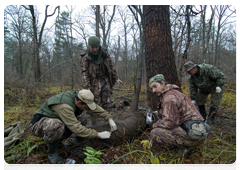MULTIMEDIA
 +
+
Researchers capture Amur tigers in the taiga to take samples of their blood, hair and feces for subsequent molecular, genetic and hormone analysis
 +
+
Researchers capture Amur tigers in the taiga to take samples of their blood, hair and feces for subsequent molecular, genetic and hormone analysis
 +
+
Researchers capture Amur tigers in the taiga to take samples of their blood, hair and feces for subsequent molecular, genetic and hormone analysis
 +
+
Researchers fastening a collar around the neck of the captured tiger. The collar has satellite-tracked GPS navigators attached to it which will transmit information about the tiger’s position to a computer
 +
+
Researchers fastening a collar around the neck of the captured tiger. The collar has satellite-tracked GPS navigators attached to it which will transmit information about the tiger’s position to a computer
 +
+
Researchers fastening a collar around the neck of the captured tiger. The collar has satellite-tracked GPS navigators attached to it which will transmit information about the tiger’s position to a computer
 +
+
Photo-traps are installed in order to take pictures of animals simultaneously from both sides, as this is the only way to make an individual portrait of each predator
 +
+
Photo-traps are installed in order to take pictures of animals simultaneously from both sides, as this is the only way to make an individual portrait of each predator
 +
+
Researchers measure the length of the body, the weight, blood pressure and pulse rate of the tiger put to sleep by an injection of anaesthetic
 +
+
Researchers measure the length of the body, the weight, blood pressure and pulse rate of the tiger put to sleep by an injection of anaesthetic
 +
+
One of the methods to research tigers is to study their tracks. A tiger can be identified by the size and form of its paw prints














 ABOUT THE PROGRAMME
ABOUT THE PROGRAMME
 AMUR TIGER: LIFE, BEHAVIOUR AND MORE
AMUR TIGER: LIFE, BEHAVIOUR AND MORE
 AMUR TIGER RESEARCH: A HISTORY
AMUR TIGER RESEARCH: A HISTORY
 VLADIMIR PUTIN'S VISIT
VLADIMIR PUTIN'S VISIT
 NEWS
NEWS
 MULTIMEDIA
MULTIMEDIA